Nicotinamide adenine dinucleotide (NAD+) is a vital coenzyme present in every cell of the body. It plays a central role in energy production, redox balance, DNA repair, and cellular signaling. On the Neurotransmitter XL panel, NAD+ serves as a critical marker linking tryptophan metabolism, mitochondrial efficiency, and the body’s stress–energy balance.
Derived from both dietary niacin (vitamin B3) and tryptophan metabolism via the kynurenine pathway, NAD+ acts as an electron carrier in oxidative reactions. It cycles between its oxidized (NAD+) and reduced (NADH) forms to drive ATP generation in mitochondria. Because it is also essential for enzymes involved in gene expression (sirtuins), detoxification, and neurotransmitter balance, its availability profoundly influences mental clarity, resilience, and metabolic vitality.
Low NAD+ levels, as detected on this panel, can indicate mitochondrial dysfunction, oxidative stress, inflammation, or nutrient deficiency, while elevated NAD+ may reflect enhanced redox turnover or increased cellular demand under stress or repair processes.
The inclusion of NAD+ in the Neurotransmitter XL profile offers a deeper understanding of how cellular energy metabolism connects to neurotransmitter function and stress response. Because NAD+ is synthesized through both niacin intake and the tryptophan–kynurenine–quinolinic acid pathway, it bridges nutrition, inflammation, and neurochemistry.
A healthy NAD+ balance supports:
Mitochondrial energy production (ATP synthesis via oxidative phosphorylation).
Neurotransmitter synthesis and metabolism (particularly serotonin, dopamine, and noradrenaline).
DNA repair and protection through activation of PARP enzymes.
Cellular aging and stress adaptation via sirtuin activation.
Antioxidant recycling, maintaining glutathione and redox stability.
When NAD+ levels drop, the body’s ability to manage oxidative stress, repair damage, and sustain energy declines—manifesting as fatigue, cognitive sluggishness, mood imbalance, or slower recovery from stress.
NAD+ can be generated through two main routes:
Begins with tryptophan, which is converted via kynurenine and quinolinic acid into NAD+.
This pathway links amino acid metabolism to energy production.
It depends on enzymes such as indoleamine 2,3-dioxygenase (IDO) and quinolinate phosphoribosyltransferase (QPRT), which require cofactors like magnesium, vitamin B6, and iron.
Chronic stress, inflammation, or toxins (e.g., phthalates) can inhibit QPRT, blocking quinolinic acid’s conversion and reducing NAD+ synthesis.
Use dietary niacin (vitamin B3), nicotinamide, or nicotinamide riboside (NR) to regenerate NAD+.
These pathways rely on adequate intake of B vitamins and magnesium for efficient recycling.
Both pathways work together to ensure a steady NAD+ supply, though the balance between them can shift depending on diet, inflammation, and mitochondrial health.
High NAD+ may reflect increased oxidative turnover—a compensatory upregulation to meet energy or repair demands. It can be seen in:
Acute stress response or heightened mitochondrial activity.
High energy output from exercise or metabolic acceleration.
Supplemental NAD+ or precursor use (e.g., niacinamide, NR, NMN).
However, sustained elevations without corresponding energy output may also signal oxidative strain or mitochondrial overactivation, where NAD+ production rises to offset increased redox stress.
Decreased NAD+ levels are far more common and clinically significant. They can result from:
Chronic stress or inflammation, which overactivates PARP enzymes and depletes NAD+ for DNA repair.
Nutrient deficiencies in niacin, vitamin B6, magnesium, or tryptophan.
Mitochondrial dysfunction, reducing NAD+/NADH cycling efficiency.
Toxin exposure (e.g., phthalates, heavy metals), impairing QPRT enzyme activity.
Low tryptophan or kynurenine pathway inactivity, reducing de novo NAD+ formation.
Consequences include low ATP output, oxidative imbalance, and compromised neurotransmitter regulation, often accompanied by fatigue, low mood, cognitive dullness, and slower cellular repair.
| System | Low NAD+ Effects | High NAD+ Effects |
|---|---|---|
| Energy & Metabolism | Fatigue, sluggish ATP production, metabolic slowdown | Increased redox turnover, compensatory response to stress |
| Nervous System | Impaired neurotransmitter metabolism (dopamine, serotonin) | Possible overactivation of sirtuin pathways |
| Mitochondria | Reduced oxidative phosphorylation, higher oxidative stress | Enhanced mitochondrial biogenesis (if balanced) |
| Cellular Repair | Slower DNA repair, accelerated aging | Potential protection against oxidative damage |
| Mood & Cognition | Low motivation, brain fog, depressive tendencies | Heightened mental alertness (short-term) |
In essence, low NAD+ represents cellular fatigue, while high NAD+ indicates metabolic strain or compensatory activation. Both states highlight the delicate balance between oxidative demand and repair capacity.
| Related Marker | Interpretation Insight |
|---|---|
| Quinolinic Acid | Low NAD+ with elevated quinolinic acid suggests blocked conversion due to enzyme or cofactor deficiency. |
| Tryptophan / Kynurenine | Low tryptophan or kynurenine with low NAD+ reflects insufficient precursor supply. |
| Neopterin | Elevated neopterin (immune activation) often depletes NAD+ through PARP enzyme activity. |
| SAM / SAH Ratio | Depressed methylation capacity may reduce NAD+ synthesis and recycling. |
| Lactate / Pyruvate | High ratios indicate impaired mitochondrial NADH oxidation, slowing ATP production. |
By assessing NAD+ alongside these markers, the Neurotransmitter XL panel identifies whether energy imbalances stem from nutrient depletion, inflammation, enzyme dysfunction, or mitochondrial inefficiency.
Persistent NAD+ depletion can lead to:
Chronic fatigue and low stamina
Brain fog, memory decline, and concentration issues
Depressive or anxious states due to neurotransmitter disruption
Mitochondrial aging and oxidative stress
Reduced cellular repair and accelerated biological aging
Dysregulated glucose and lipid metabolism
Conversely, sustained increases in NAD+ turnover without resolution of oxidative stress can eventually exhaust precursors and lead to secondary depletion.
Ensure sufficient intake of vitamin B3 (niacin, niacinamide), vitamin B6, magnesium, and tryptophan-rich foods (turkey, eggs, tofu, salmon).
Consider targeted NAD+ precursors such as nicotinamide riboside (NR) or nicotinamide mononucleotide (NMN), under medical supervision.
Enhance mitochondrial redox cycling with CoQ10, alpha-lipoic acid, carnitine, and ribose.
Maintain aerobic conditioning through moderate endurance exercise, which improves NAD+/NADH balance.
Lower chronic immune activation with omega-3 fatty acids, curcumin, and resveratrol.
Support antioxidant systems via vitamin C, selenium, glutathione, and N-acetylcysteine (NAC).
Minimize exposure to environmental toxins (e.g., phthalates, heavy metals) that inhibit QPRT and NAD+ synthesis.
Balance detoxification and methylation pathways through adequate SAM, choline, and betaine availability.
Deep sleep and circadian rhythm balance naturally enhance NAD+ regeneration and mitochondrial repair.
NAD+ is the metabolic bridge between nutrition, neurotransmission, and cellular energy. It transforms the body’s dietary and biochemical inputs into the energy required for every physiological process. On the Neurotransmitter XL panel, NAD+ serves as a window into the state of mitochondrial health, redox balance, and stress adaptation.
Low levels point to nutrient deficiency, inflammation, or mitochondrial slowdown, while elevated levels reflect heightened energy turnover or oxidative strain.
Interpreting NAD+ alongside tryptophan, quinolinic acid, neopterin, and redox markers allows for a precise understanding of where cellular metabolism may be faltering.

Import lab results from multiple providers, track changes over time, customize your reference ranges, and get clear explanations for each result. Everything is stored securely, exportable in one organized file, and shareable with your doctor—or anyone you choose.
Cancel or upgrade anytime
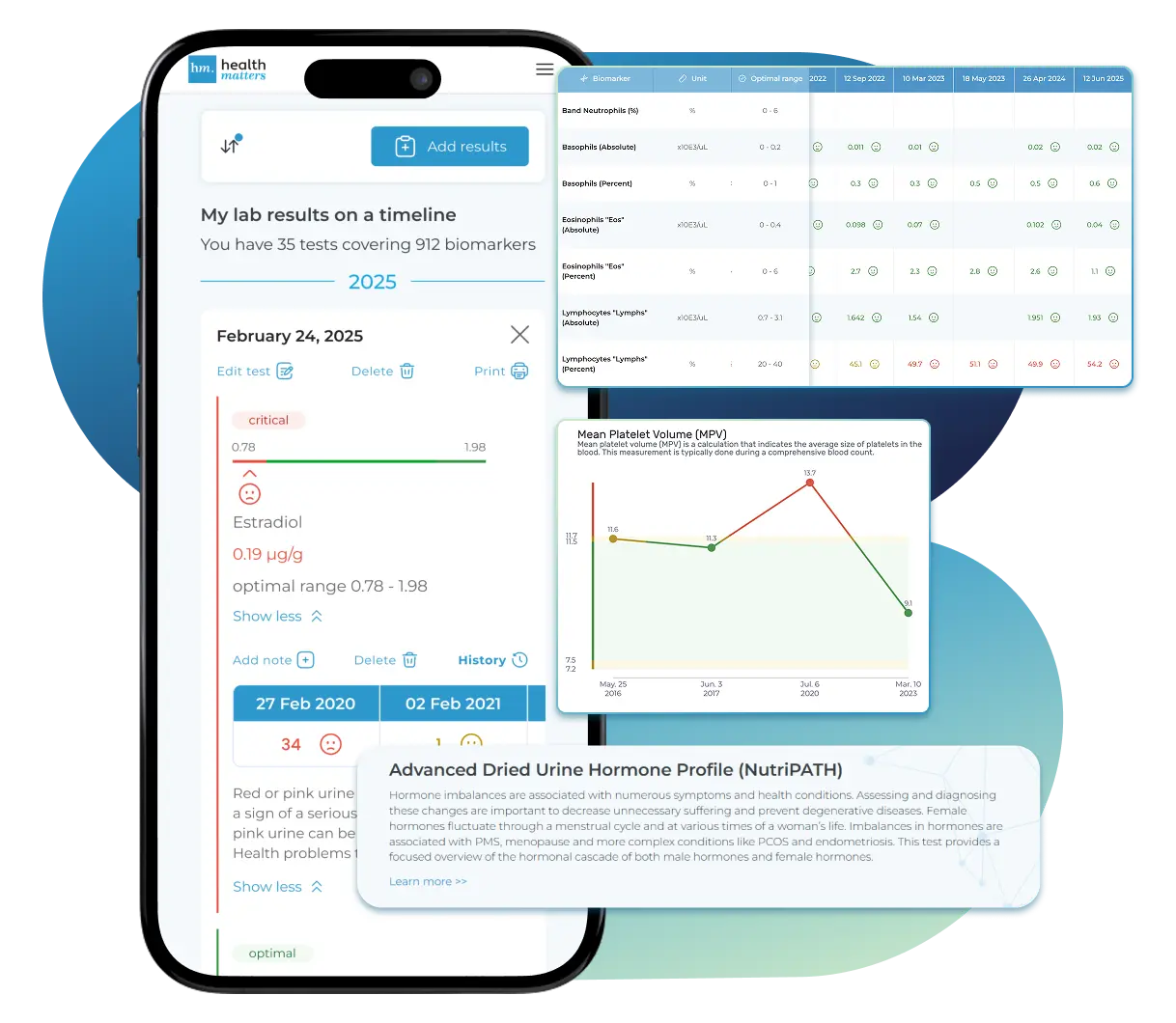
A low NAD+ level on the Neurotransmitter XL panel signals an energy and redox imbalance at the cellular level. NAD+ is the cornerstone of mitochondrial ATP production, DNA repair, neurotransmitter metabolism, and oxidative stress regulation. When NAD+ is depleted, cells lose their ability to efficiently generate energy and repair damage, leading to fatigue, cognitive decline, poor stress tolerance, and accelerated aging.
Since NAD+ is produced both from dietary niacin (vitamin B3) and through tryptophan metabolism via the kynurenine–quinolinic acid pathway, a deficiency often reflects disruption in these metabolic routes. Low levels may arise from nutrient deficiency, mitochondrial dysfunction, oxidative or nitrosative stress, or overactivation of cellular repair enzymes that consume NAD+ in response to inflammation or DNA damage.
NAD+ exists in two forms — oxidized (NAD+) and reduced (NADH) — and continuously cycles between them to sustain cellular respiration and redox balance. It’s essential for:
Energy production (ATP synthesis via oxidative phosphorylation)
Neurotransmitter metabolism, including serotonin, dopamine, and noradrenaline synthesis and degradation
Sirtuin and PARP enzyme activity for DNA repair and longevity signaling
Methylation and detoxification processes
Maintaining mitochondrial health and resilience under stress
When NAD+ levels drop, energy production slows, stress tolerance weakens, and oxidative byproducts accumulate. This metabolic slowdown can impact nearly every organ system, particularly the brain, muscles, and liver.
Persistent psychological or physical stress triggers immune activation and increases activity of PARP (poly-ADP-ribose polymerase)—an enzyme that repairs DNA but consumes large amounts of NAD+. Chronic inflammation, infections, or toxin exposure can therefore rapidly deplete NAD+ reserves.
Neopterin elevation on the same panel often confirms immune activation driving NAD+ loss.
In these cases, the depletion reflects increased consumption, not necessarily poor synthesis.
NAD+ synthesis depends heavily on:
Niacin (Vitamin B3) – the direct precursor of NAD+ in the salvage pathway.
Vitamin B6 and Magnesium – essential cofactors for enzymes in the tryptophan–kynurenine–quinolinic acid pathway.
Iron and Zinc – support redox and enzyme activity within mitochondria.
A diet low in these nutrients, malabsorption, or high metabolic turnover can lead to reduced NAD+ production.
Tryptophan serves as a major indirect source of NAD+. If the kynurenine pathway is underactive or blocked, NAD+ synthesis falls.
Low levels of kynurenine or quinolinic acid indicate reduced throughput toward NAD+ formation.
Enzymatic inhibition (e.g., by toxins such as phthalates) can block the conversion of quinolinic acid into NAD+, even when upstream metabolites are adequate.
This results in energy deficits, low serotonin, and reduced mitochondrial resilience.
Mitochondria require NAD+ for ATP generation. When oxidative stress damages mitochondrial enzymes or membranes, NAD+ cycling between NADH and NAD+ slows down.
Elevated lactate/pyruvate ratios on the Neurotransmitter XL panel may indicate this pattern.
Damaged mitochondria also overproduce free radicals, further consuming NAD+ through repair pathways.
This creates a cycle of low energy, increased oxidative burden, and further NAD+ depletion.
When DNA damage occurs—through inflammation, toxins, radiation, or chronic stress—PARP enzymes repair it by consuming NAD+. Excessive activation of PARPs depletes NAD+ pools, leaving less available for energy metabolism and neurotransmitter balance.
This mechanism is commonly observed in chronic inflammatory conditions, viral infections, and neurodegenerative processes.
As we age, NAD+ synthesis declines due to reduced enzyme activity, mitochondrial wear, and slower recycling of precursors.
Age-related inflammation (“inflammaging”) further accelerates NAD+ loss.
The result is slower metabolism, weaker cellular repair, and higher vulnerability to fatigue and neurocognitive symptoms.
Because NAD+ is foundational to so many cellular processes, its depletion manifests in a wide spectrum of symptoms:
Low energy, chronic fatigue, and poor exercise tolerance
Brain fog, poor concentration, and memory lapses
Mood changes — depression, anxiety, or apathy
Sleep disturbances and unrefreshing rest
Poor stress resilience (“burnout” sensation)
Cold hands/feet or low basal temperature (slowed metabolism)
Increased inflammation and oxidative stress markers
Accelerated aging signs (wrinkles, loss of skin elasticity, slow recovery)
| Related Marker | Interpretation Insight |
|---|---|
| Tryptophan / Kynurenine / Quinolinic Acid | Low NAD+ with low tryptophan metabolites suggests impaired precursor flow or enzyme inhibition. |
| Neopterin | Elevated neopterin indicates inflammation-driven NAD+ consumption through PARP activation. |
| Lactate / Pyruvate / Citrate | Abnormal ratios suggest mitochondrial energy deficit causing NADH accumulation and low NAD+. |
| SAM / SAH Ratio | Impaired methylation can limit NAD+ regeneration. |
| Vitamin B3 (Niacin), Cystathionine, or Methylmalonic Acid | Abnormalities suggest cofactor deficiencies affecting NAD+ synthesis and recycling. |
By analyzing NAD+ alongside these markers, clinicians can pinpoint whether the depletion results from overuse (inflammation), underproduction (nutrient or enzyme issues), or mitochondrial energy failure.
Chronic NAD+ depletion has broad-reaching effects:
Energy Deficits – Low ATP output reduces physical and mental stamina.
Neurotransmitter Imbalance – Impaired redox reactions affect dopamine and serotonin turnover.
Mitochondrial Decline – Reduced oxidative phosphorylation increases fatigue and oxidative damage.
Accelerated Aging – Diminished sirtuin activity weakens DNA repair and metabolic resilience.
Immune Dysfunction – Insufficient NAD+ compromises innate defense and inflammatory control.
Left unaddressed, NAD+ depletion perpetuates a cycle of oxidative stress, neurochemical imbalance, and metabolic exhaustion.
Niacin (Vitamin B3), Niacinamide, or Nicotinamide Riboside (NR) – directly support NAD+ synthesis.
Nicotinamide Mononucleotide (NMN) – advanced precursor that may boost cellular NAD+ more efficiently.
Ensure adequate vitamin B6, magnesium, zinc, and iron to support enzymatic reactions in the kynurenine–NAD+ pathway.
Address folate and B12 deficiencies, which can indirectly limit NAD+ regeneration.
Correct low tryptophan through diet (eggs, turkey, tofu, salmon) or amino acid supplementation under supervision.
Balance gut health and microbiome composition to optimize tryptophan absorption and metabolism.
Support mitochondrial resilience with CoQ10, alpha-lipoic acid, L-carnitine, and ribose.
Engage in moderate aerobic exercise, which naturally improves NAD+/NADH cycling.
Minimize chronic inflammation through omega-3 fatty acids, curcumin, resveratrol, and antioxidant support.
Limit exposure to toxins and environmental pollutants that damage DNA and activate PARPs.
Practice restorative sleep and stress management, both essential for NAD+ recovery.
Low NAD+ levels reflect a state of cellular energy depletion and metabolic imbalance—often caused by nutrient deficiency, chronic inflammation, oxidative stress, or impaired tryptophan metabolism. Because NAD+ underpins mitochondrial energy production, DNA repair, and neurotransmitter regulation, its deficiency affects both physical and mental vitality.
On the Neurotransmitter XL panel, interpreting NAD+ alongside tryptophan, quinolinic acid, neopterin, and mitochondrial markers provides valuable insight into the biochemical roots of fatigue, stress intolerance, and poor recovery.
Laboratories
We accept reports from any lab, so you can easily collect and organize all your health information in one secure spot.

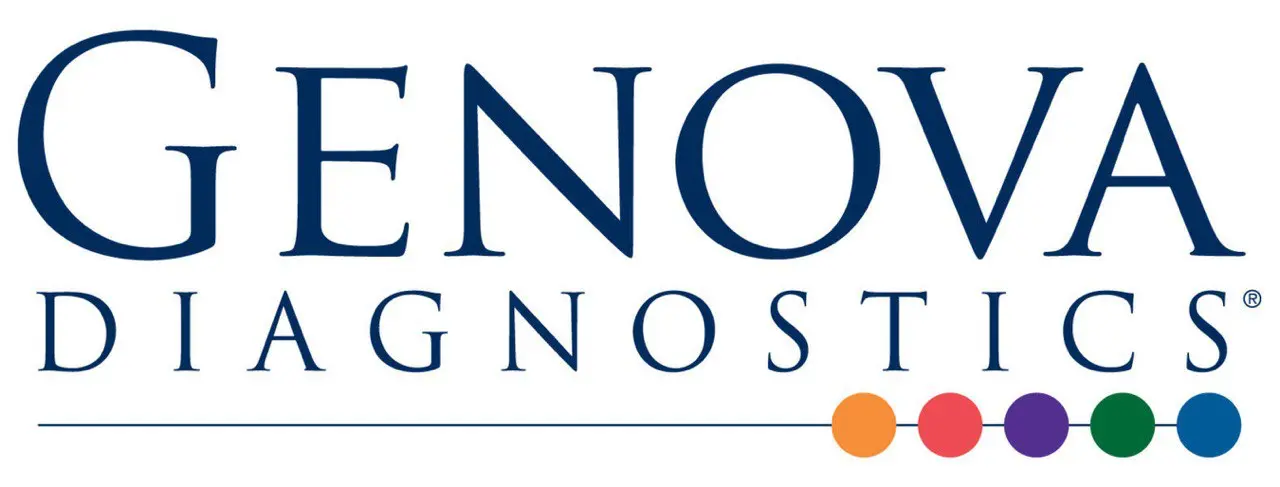
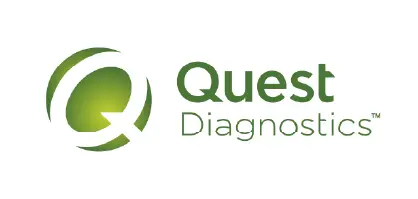

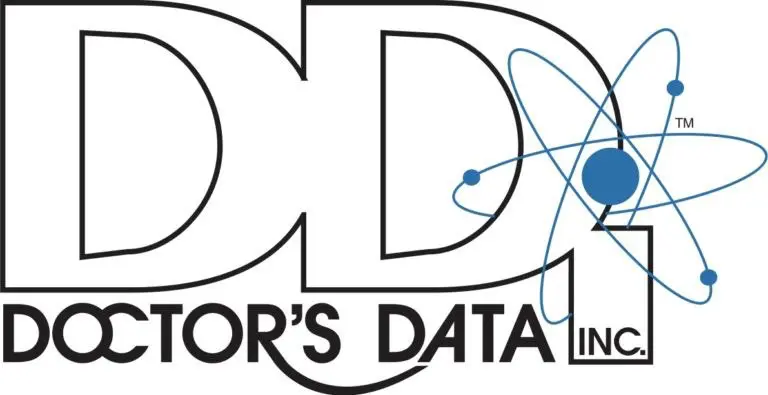





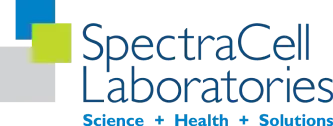
Pricing Table
Choose the plan that fits you — and turn scattered lab reports into clear insights you can finally use.
Pick a plan that fits you — and turn scattered lab reports into clarity.
Personal plans
Professional plan
$15/ month
Access your lab reports, explanations, and tracking tools.
$250/ once
Pay once, access everything—no monthly fees, no limits.
Professional plan
$45/ month
Designed for professionals managing their clients' lab reports
About membership
 Import Lab Results from Any Source
Import Lab Results from Any Source
Easily upload lab results from any provider, whether it's a hospital, independent lab, or home testing service. We support PDFs, scanned documents, and JPEGs from patient portals. No need to log in to multiple platforms — everything is centralized in one secure space.
Easily upload lab results from any provider — we support PDFs, scans, and images. Keep all your reports organized in one secure place.
 See Your Health Timeline
See Your Health Timeline
Every lab result is automatically organized on a chronological timeline, giving you a complete picture of your health journey. Whether you're tracking a condition, managing treatments, or staying proactive, the timeline helps you and your doctor understand how things progress over time.
Every lab result is automatically organized on a chronological timeline, giving you a complete picture of your health journey.
 Understand What Your Results Mean
Understand What Your Results Mean
Whether it's a blood test, GI panel, urinalysis, or something else, lab reports measure numerous biomarkers that reveal what's happening inside your body. Our extensive database covers over 10,000 biomarkers, providing clear, simple explanations of what each result means and how you can take action—no matter your membership level. Say goodbye to confusion and get the insights you need to better understand your health.
Our database covers over 10,000 biomarkers with clear, simple explanations—so you can finally understand your results and what to do next.
 Enter Your Lab Reports Yourself — Always Free
Enter Your Lab Reports — Always Free
Enter Your Lab Reports Yourself — Always Free
Enter Your Lab Reports — Always Free
If you'd like to handle inputting your health data into your account, you can do so with our easy-to-use data entry forms. Our user-friendly form is designed to guide you through the quick and easy submission process, making it simple to keep track of your health metrics. This is available to both Complete plan and Unlimited plan members.
Our user-friendly form guides you through a quick, simple submission process, making it easy to enter your health metrics.
Add your results anytime with our easy entry form. It's quick, guided, and helps you stay organized — free for all members.
 Visualize Your Results
Visualize Your Results
View your lab data through easy-to-read graphs and tables. Quickly spot patterns, track changes, and compare results across different dates — all without digging through multiple reports. You can also select and compare graphs of specific biomarkers side-by-side to better understand how they relate and change over time.
See your lab reports in clear graphs and tables. Spot patterns, track changes, and compare results over time — all in one place.
 Export Your Complete Lab History in a Single File
Export Your Complete Lab History
Export Your Complete Lab History in a Single File
Export Your Complete Lab History
After collecting lab results from different providers, you can download your entire history combined into a single file. Choose from PDF, Excel, or CSV formats to easily review, share, or get a second opinion—no more juggling multiple reports.
After collecting lab results from different providers, you can download your entire history combined into a single file.
 Comprehensive Data Entry Service for Your Reports
Data Entry Service for Your Reports
Comprehensive Data Entry Service for Your Reports
Data Entry Service for Your Reports
Our inclusive service handles the data entry for your lab reports. Just submit your information and we'll take care of the rest. Complete plan members receive one report entered for free, then $15 per report after that. Unlimited plan members receive ten report entries for free, then $15 per report after that.
Our inclusive service handles the data entry for your lab reports. Just submit your information and we'll take care of the rest.
 Securely Share With Anyone You Trust
Securely Share With Anyone You Trust
Whether you're working with a doctor, nutritionist, caregiver, or wellness coach, you can securely share your complete lab history by sending an invite link to anyone you trust. You have full control over who sees your information and for how long, ensuring your privacy and peace of mind at every step.
Share your full lab history with your doctor, nutritionist, or coach using a secure invite link.
Discover






I have been using Healthmatters.io since 2021. I travel all over the world and use different doctors and health facilities. This site has allowed me to consolidate all my various test results over 14 years in one place. And every doctor that I show this to has been impressed. Because with any health professional I talk to, I can pull up historical results in seconds. It is invaluable. Even going back to the same doctor, they usually do not have the historical results from their facility in a graph format. That has been very helpful.
Anthony
Unlimited Plan Member since 2021

What fantastic service and great, easy-to-follow layouts! I love your website; it makes it so helpful to see patterns in my health data. It's truly a pleasure to use. I only wish the NHS was as organized and quick as Healthmatters.io. You've set a new standard for health tracking!
Karin
Advanced Plan Member since 2020

As a PRO member and medical practitioner, Healthmatters.io has been an invaluable tool for tracking my clients' data. The layout is intuitive, making it easy to monitor trends and spot patterns over time. The ability to customize reports and charts helps me present information clearly to my clients, improving communication and outcomes. It's streamlined my workflow, saving me time and providing insights at a glance. Highly recommended for any practitioner looking for a comprehensive and user-friendly solution to track patient labs!
Paul
Healthmatters Pro Member since 2024
Healthmatters is a personal health dashboard that helps you organize and understand your lab results. It collects and displays your medical test data from any lab in one secure, easy-to-use platform.
With a Healthmatters account, you can:
Professionals can also analyze client data more efficiently and save time managing lab reports.
Healthmatters.io personal account provides in-depth research on 4000+ biomarkers, including information and suggestions for test panels such as, but not limited to:
You can combine all test reports inside your Healthmatters account and keep them in one place. It gives you an excellent overview of all your health data. Once you retest, you can add new results and compare them.
If you are still determining whether Healthmatters support your lab results, the rule is that if you can test it, you can upload it to Healthmatters.
While we work with many popular labs, we welcome reports from lots of other places too.
It's as simple as this: if you can get a test done, you can upload it to Healthmatters and we can interpret results from any lab out there. If laboratories can analyze it, we can interpret it.
If you're on the hunt for a specific biomarker, contact us and we'll add it to our database. Anything from blood, urine, saliva, or stool can be uploaded, understood, and tracked with your Healthmatters account.
The Complete Plan ($15/month) is perfect for individuals who want ongoing access to their health data. It includes unlimited lab imports, visual tracking, custom ranges, result explanations, full account exports, and secure sharing — all with a simple monthly subscription. You can cancel anytime and restart your plan whenever you're ready — your data will still be there waiting for you. You can also upgrade to the Unlimited Plan at any time, with the cost prorated based on what you've already paid.
The Unlimited Plan ($250 one-time) is also designed for individuals but offers lifetime access with no ongoing subscription. You'll get all the same features as the Complete Plan, plus a larger initial data entry allowance (10 reports), making it a great choice if you prefer a one-time payment and long-term use without monthly fees.
In short:
There are two ways to add your test reports to your Healthmatters account. One option is to input the data using the data entry forms. The other method is to utilize our "Data entry service."
Our data entry forms offer an easy, fast, and free way for you to input the reports yourself. Self-entry allows you to add an unlimited number of reports at no cost. We make the self-entry process user-friendly, providing dozens of templates that pre-populate the most popular laboratory panels and offering instant feedback on entered values.
For those who prefer assistance, we offer a "Data entry service" to help you input your data. Simply attach an image or file of your lab test results, and a qualified team member from our data entry team will add the results for you.
We support various file types, including PDFs, JPGs, or Excel. This service is particularly useful if you have many reports to upload or if you're too busy to handle the data entry yourself.
Our Data Entry Service is for when you don't want to manually type in your lab results yourself. You simply upload your report (PDF, image, or screenshot), and our trained team enters the information into your Healthmatters account for you — accurately and neatly organized, ready to view in graphs, tables, and timelines.
The $15 per report covers the time and care it takes for a real person to review your file, make sure each result is entered correctly, and double-check for accuracy. This ensures your health data is precise and easy to work with — without you having to spend the time doing it yourself.
Prefer to do it yourself? You can always use our free self-entry tool to add results manually — it just takes a bit more time and attention.
For users on the Complete monthly plan, the first report is entered free of charge, and each additional report incurs a fee of $15.
Unlimited account holders enjoy the entry of ten reports without charge. Subsequent reports are subject to a $15 fee per report.
Additionally, users on the Complete plan can upgrade to a yearly subscription from the account settings. The annual subscription includes a data entry service for five reports.
All professional accounts allow you to import and onboard an unlimited number of clients and their lab results. The distinction between professional plans lies solely in the data entry service.
The Pro Monthly Plus plan is priced at $75 per month and includes a data entry service for five reports each month. Additional reports can be self-entered at no extra cost or, if preferred, you can use our data entry service for an additional fee of $15 per report.
The Pro Monthly plan is priced at $45 per month and does not include a data entry service. Self-entry is free for an unlimited number of reports, and you can opt for the data entry service at a fee of $15 per report.
You also have the option to upgrade to higher monthly or to annual plans, which come with substantial discounts. All upgrades can be done directly from your account.
Simply log in and navigate to your account settings to cancel your subscription. Scroll down to locate the 'Cancel' button at the bottom of the page. Ensure you cancel at least one day before the renewal date to prevent any charges. Once cancellation is requested, the subscription remains active until the conclusion of the current billing cycle.
Our goal has been to make your Healthmatters account as intuitive as possible.
We've crafted multiple ways for you to navigate your data, whether you're glancing at a single report or delving into your historical test reports.
1. Graph View:Dive into a visual journey with our biomarker graphs, showcasing over 40 data points. Combining years of results unveils trends, empowering you to make informed decisions. Our visualization tools make it a breeze to compare and understand changes over time, even if your results are from different labs. A search function and filters simplify the exploration of extensive data, allowing you to focus on what needs attention.
2. All Tests ViewExplore neatly organized reports on a timeline, highlighting crucial details like dates, critical results, and lab/panel names. Each report opens up to reveal in-depth descriptions and additional recommendations for each biomarker. The history of previous results is just a click away, and you can download a comprehensive report for deeper insights. Color-coded and user-friendly, it's designed for easy reading, understanding, and navigation.
3. Table View:For a holistic view of all biomarkers side by side, our table view is your go-to. Results are neatly displayed in a categorized and dated table, ideal for those with an extensive test history. Utilize sorting, filters, and color-coding to enhance your analysis and gain extra insights.
Yes, you can download your information anytime. We offer two easy ways to export your lab data:
This makes it simple to save, back up, or share your health data whenever you need.
Yes, you can print your report. To do so, navigate to "All tests" and open the report you wish to print. You'll find a print button in the right corner of the report. Click on it, and your browser's print window will open. If you prefer to print in a bigger typeface, adjust the scale using the print window settings.
Yes, you can! We highly recommend activating Two-Factor Authentication (2FA) for your account. To do so, please navigate to the "Profile and Security" section of your account, where you will find instructions for activating 2FA.
Yes, you can. When entering values for the biomarker, you will see an "Edit Range" button. Click this button, and you'll have the option to enter a custom range.
A personal account is all about keeping your own lab test results in check. It's just for you and your personal use.
The professional account is designed for health professionals who wish to track and organize their clients' laboratory results.
To learn more about Healthmatters Pro, please refer to the professional page.
At HealthMatters, we're committed to maintaining the security and confidentiality of your personal information. We've put industry-leading security standards in place to help protect against the loss, misuse, or alteration of the information under our control. We use procedural, physical, and electronic security methods designed to prevent unauthorized people from getting access to this information. Our internal code of conduct adds additional privacy protection. All data is backed up multiple times a day and encrypted using SSL certificates. See our Privacy Policy for more details.

